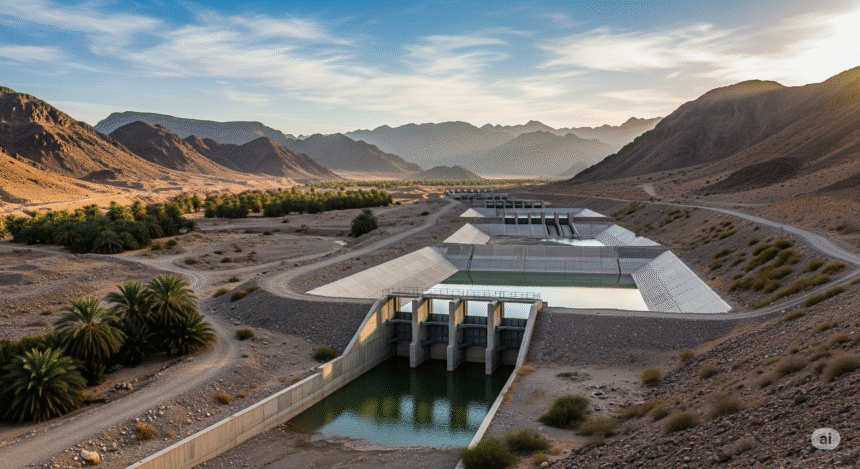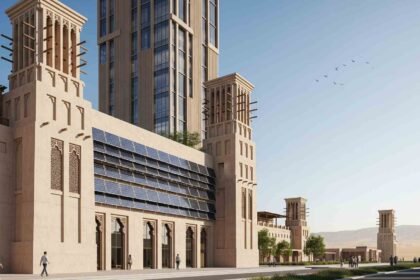Oman’s Ministry of Agriculture, Fisheries, and Water Resources has unveiled a plan to build 18 new groundwater recharge dams across the A’Dhahirah region, marking a significant push to enlarge and protect the country’s water reserves for the future.
This initiative arrives as part of a broader community‑partnership effort. Residents of local wilayats, districts including Ibri, Yanqul, and Dhank, are teaming up with government teams to make these dams a reality. The project is structured so that the ministry covers 20 percent of the cost, while local citizens contribute the remaining 80 percent.
Current Progress and Distribution
According to Eng. Mubarak Salim Al Jabri, Director of the Water Resources Department in A’Dhahirah Governorate, said construction is already underway on seven of the 18 dams:
- Three dams in the wilayat of Ibri
- Three dams in the wilayat of Yanqul
- One dam in the wilayat of Dhank
These structures are designed to capture rainwater and recharge aquifers, helping to stabilise well water levels and support aflaj irrigation systems that serve local farms.
Water Infrastructure Snapshot
A’Dhahirah already possesses 36 dams, evenly split between:
- 18 government‑funded dams
- 18 community‑financed dams built through local partnerships
This latest development will bring the total number of community partnership dams to 36, making the public–private effort equally robust and visible.
Why These Dams
Al Jabri highlighted the vital role of recharge dams in bolstering the water supply. By reinvigorating groundwater levels, these dams help sustain wells and aflaj systems, which in turn support irrigation and agricultural activity. The dams help support food security and local livelihoods, especially in regions prone to irregular rainfall.
This year, eight existing dams in A’Dhahirah underwent maintenance. That work sought to restore their full capacity to collect and filter rainwater into the groundwater network.
Community Involvement and Sustainability
The partnership model underlines a growing focus on collective resource stewardship. By sharing the cost burden, where citizens fund much of the work, the project embodies a form of local ownership and responsibility across A’Dhahirah’s wilayats. Al Jabri described this as a symbol of how integrated community and government planning can safeguard resources.
Residents across Ibri, Yanqul, and Dhank have reportedly welcomed the initiative. Their contributions include monetary support, land access, local coordination, and upkeep of the sites under construction and beyond.
Expected Benefits and Goals
Officials expect the completed dams to:
- Increase groundwater volume and stability
- Boost water availability for agriculture
- Enhance resilience during dry seasons
- Enable long‑term, sustainable rural development
The reservoirs created will feed wells and traditional aflaj water channels. This should directly benefit farmers and households, particularly in remote communities.
Timeline
Construction of the remaining 11 dams is expected to roll out over the coming months. The ministry aims to coordinate closely with local authorities to track progress, ensure technical oversight, and manage joint contributions from citizens.
Regular inspections, technical assessments, and training workshops for local maintenance teams are planned to keep the dams working as intended beyond the initial build phase.
Broader Context: Water Security in Oman
Oman faces ongoing pressure on its water reserves. As rainfall varies and aquifers draw down, recharge dams have become a key tool in the national water management strategy. The new dams in A’Dhahirah align with Oman’s wider efforts to preserve groundwater and support the agricultural sector.
In recent years, similar community‑driven projects have unfolded in other regions of the Sultanate, reflecting a growing trend in local government collaboration. These models double as social and environmental investments, reinforcing rural stability.
Voices from the Ground
Eng. Al Jabri remarked that the partnership dams play a fundamental role in securing water infrastructure and advancing sustainable farming. He said they reinforce an essential pillar of community resilience in A’Dhahirah.
While no official names or quotes from citizen contributors were released, press coverage emphasised local enthusiasm for the project, with many expressing hope that the new dams will reduce water shortages and improve irrigation outcomes in the coming seasons.
Oman’s decision to build 18 new groundwater recharge dams in A’Dhahirah marks a significant stride in local water resilience. Anchored in close cooperation between the government and local communities, the project blends shared funding, technical support, and grassroots engagement.
If completed on schedule, these dams will not only restore and increase groundwater reserves but also strengthen agricultural systems, support rural water users, and chart a sustainable path for resource use in one of Oman’s key interior governorates.







